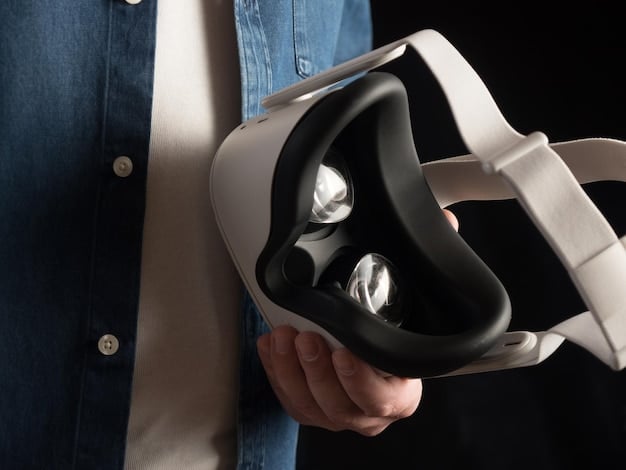VR Headsets 2025: Resolution, Refresh Rate, Field of View Guide

Navigating the future of virtual reality, discerning the ideal VR headsets in 2025: what to look for in resolution, refresh rate, and field of view is paramount for an immersive and comfortable experience, as these core specifications define the quality of virtual environments.
The landscape of virtual reality is evolving at an unprecedented pace. As we inch closer to 2025, the choices facing consumers looking to invest in a new VR headset become increasingly complex. Understanding the critical technical specifications—specifically resolution, refresh rate, and field of view—is no longer a mere technicality; it’s essential for anyone seeking truly immersive, comfortable, and high-fidelity virtual experiences.
The cornerstone of immersion: resolution in 2025 VR headsets
Resolution in VR headsets refers to the number of pixels displayed in each eye. A higher resolution means more pixels, leading to a sharper, more detailed image and significantly reducing the “screen door effect” (SDE), where the gaps between pixels are visible. As we approach 2025, advancements in display technology are pushing boundaries.
The demand for ultra-high-definition content and increasingly realistic virtual environments necessitates displays capable of rendering intricate details. Early VR headsets struggled with low resolutions, making text hard to read and distant objects blurry. Today’s premium headsets offer resolutions that begin to rival high-end monitors, providing a much clearer window into virtual worlds.
Understanding pixel density and its importance
Beyond raw pixel counts, pixel density (often measured in pixels per degree or PPD) is a crucial metric. PPD accounts for the angular resolution, meaning how many pixels are packed into each degree of your field of view. A higher PPD delivers a clearer, less pixelated image, especially when looking at details or reading fine print within the virtual environment.
- Minimal SDE: Improved pixel density virtually eliminates the screen door effect, making the visual experience seamless.
- Enhanced Clarity: Text, fine details, and distant objects appear much sharper and more readable.
- Reduced Eye Strain: A clearer image reduces the effort your eyes need to make sense of the virtual world, leading to less fatigue.
For 2025, expect headsets to push past 4K per eye, with some high-end models potentially hitting 8K or even higher resolutions. This leap
will allow for unprecedented visual fidelity, making virtual objects almost indistinguishable from reality.
Foveated rendering: a game-changer for resolution
Foveated rendering is an advanced technique that leverages eye-tracking technology to optimize graphical rendering. It works by reducing the resolution in your peripheral vision, where human eyes are less sensitive to detail, and rendering the central part of your vision (the fovea) at maximum resolution. This technique significantly reduces the computational power required to deliver high fidelity visuals.
As eye tracking becomes standard in VR headsets by 2025, foveated rendering will be instrumental in achieving ultra-high resolutions without demanding impossible GPU power. This means smoother experiences and more complex virtual worlds rendered beautifully.
In essence, when considering resolution for a 2025 VR headset, look beyond just the numbers. Understand how pixel density and foveated rendering contribute to the overall visual quality and your immersive experience. The goal is a crystal-clear window into your virtual adventures, free from distracting pixelation or motion blur.
Smoothness redefined: refresh rate considerations for 2025
The refresh rate of a VR headset refers to how many times per second the display updates the image. Measured in hertz (Hz), a higher refresh rate translates to a smoother, more fluid visual experience, which is particularly vital in virtual reality to prevent motion sickness and enhance immersion. In 2025, the baseline for comfortable VR will be significantly higher than current standards.
Early consumer VR headsets typically ran at 60Hz or 90Hz. While 90Hz became the accepted minimum for many, a noticeable difference in fluidity could still be felt when compared to real-world motion. The human eye and brain are incredibly good at detecting even subtle discrepancies, and in VR, these can lead to discomfort, nausea, or a sense of “disconnect” from the virtual environment.
Why higher refresh rates matter for VR immersion
The sensation of presence in VR—the feeling of truly being “there”—is heavily influenced by how seamlessly the virtual world responds to your movements. A low refresh rate can cause perceived lag between your head movements and the visual update, breaking immersion and leading to simulator sickness. Conversely, a high refresh rate provides a more responsive and natural viewing experience.
- Reduced Motion Sickness: Smoother motion aligns better with our vestibular system, minimizing nausea.
- Enhanced Responsiveness: Quicker updates mean less lag between head movement and visual feedback, making interactions feel more immediate.
- Improved Presence: A seamless visual flow contributes directly to the feeling of “being there” in the virtual world.
By 2025, expect premium VR headsets to offer 120Hz or even 144Hz refresh rates as standard, with some experimental models pushing even higher. This leap will make fast-paced VR games incredibly fluid and even mundane virtual interactions feel effortlessly natural.

Adaptive refresh rate technologies
Similar to gaming monitors, VR headsets are beginning to incorporate adaptive refresh rate technologies, such as variable refresh rate (VRR). VRR synchronizes the display’s refresh rate with the GPU’s frame rate output. This prevents screen tearing and stuttering, leading to a much smoother experience, especially when the frame rate fluctuates.
In 2025, expect VRR to become a common feature, ensuring optimal performance across a wider range of hardware and content. This means that whether you’re exploring a detailed virtual city or engaging in a high-octane VR combat, your experience will remain consistently smooth and comfortable. Investing in a headset with a high and adaptive refresh rate is paramount for future-proofing your VR experience and ensuring maximum comfort and immersion.
Expanding horizons: field of view in 2025
Field of view (FoV) in a VR headset refers to the extent of the observable virtual world at any given moment, typically measured in degrees. A wider FoV mimics the natural human peripheral vision more closely, significantly enhancing immersion and reducing the “tunnel vision” effect often associated with earlier VR experiences. In 2025, advancements in optics and display placement are poised to deliver substantially broader FoVs.
Early VR headsets were limited by narrow fields of view, akin to looking through binoculars. This restricted sense of peripheral vision could break immersion and make users feel more like they were watching a screen than actually inhabiting a virtual space. The goal of VR is to trick the brain into believing it’s somewhere else, and a narrow FoV directly opposes that goal.
The impact of a wider field of view on immersion
A wider FoV fundamentally changes how you perceive the virtual world. With a limited FoV, your brain is constantly aware of the black borders of the display, reminding you that you’re looking at screens. As the FoV expands, these borders recede, and your peripheral vision becomes filled with the virtual environment, creating a much more convincing sense of presence.
- Enhanced Presence: A wider FoV makes the virtual world feel much larger and more encompassing, boosting the sense of “being there.”
- Reduced Disorientation: More peripheral information helps the brain orient itself within the virtual space, reducing motion sickness.
- Increased Situational Awareness: In games or simulations, a wider FoV means you can see more of your surroundings without turning your head excessively, improving gameplay and realism.
By 2025, expect mainstream headsets to offer FoVs exceeding 120 degrees horizontally, with high-end models pushing towards 160 degrees or even closer to the human eye’s natural 180-degree horizontal field of view. This expansion will be achieved through innovative lens designs, such as pancake lenses, and more strategic placement of displays.
Optical innovations driving FoV expansion
Traditional VR optics often rely on fresnel lenses, which can lead to trade-offs between FoV and visual clarity at the edges. However, new lens technologies are emerging to overcome these limitations. Pancake lenses, for example, are much thinner and can be placed closer to the display, allowing for wider FoVs in a more compact form factor.
Other optical advancements include multi-element lens systems and eye-tracking integrated optics that can dynamically adjust for optimal clarity across the entire FoV. These innovations are critical for delivering not just a wider view, but one that remains sharp and undistorted from center to edge. When assessing a 2025 VR headset, pay close attention to the stated FoV, but also research the optical design, as it will significantly impact the quality of that wider view.
Ergonomics and comfort: beyond specs for 2025 VR usage
While resolution, refresh rate, and field of view are crucial technical specifications, the overall user experience of a VR headset in 2025 will be heavily influenced by its ergonomics and comfort. A headset with cutting-edge internal technology can still be a poor choice if it’s too heavy, unbalanced, or causes discomfort after short periods of use. As VR adoption expands, wearability will become as important as graphical fidelity.
Previous generations of VR headsets were often bulky and front-heavy, leading to pressure points on the face and neck strain during extended sessions. The ongoing miniaturization of components and advancements in battery technology are enabling manufacturers to design more streamlined and balanced devices. This improved design is not just a luxury; it’s a necessity for VR to become a truly integral part of our digital lives, whether for gaming, productivity, or social interaction.
Weight distribution and balanced design
The distribution of weight is paramount for comfortable VR. A headset that is front-heavy will constantly pull down on your face, leading to pressure marks, headaches, and general fatigue. Manufacturers in 2025 are focusing on balancing the weight across the head, often by moving battery packs to the rear or integrating them into the head strap design. This shift allows for longer, more comfortable sessions without constant adjustment.
- Reduced Pressure Points: Evenly distributed weight minimizes strain on the face and nose bridge.
- Improved Stability: A balanced headset stays in place better during active use, reducing wobbling.
- Enhanced Longevity of Use: Users can wear the headset for extended periods without discomfort, making long gaming sessions or work tasks feasible.
Look for headsets that emphasize adjustable head straps and counterweights. Some high-end models even incorporate active cooling systems to prevent heat buildup, adding another layer of comfort during intensive use.

Ventilation, materials, and hygiene
Heat buildup and sweat are common issues with VR headsets. Proper ventilation systems are becoming increasingly sophisticated, using small fans or passive airflow designs to keep the user cool. The materials used for the facial interface also play a crucial role. By 2025, expect more widespread use of breathable, anti-microbial fabrics and easily replaceable interfaces for hygiene, especially in public or shared VR environments.
The ability to easily clean or replace components that come into contact with the skin will be a significant selling point, addressing consumer concerns about sharing headsets and maintaining cleanliness. Ultimately, an ideal 2025 VR headset will blend top-tier technical specifications with an ergonomic design that makes hours of comfortable use a reality, not just a promise.
Connectivity and ecosystem: a look to 2025
Beyond the core display and comfort specifications, the connectivity options and the overarching ecosystem a VR headset belongs to will significantly influence its utility and longevity in 2025. The shift from purely tethered devices to standalone and hybrid solutions is crucial, offering greater flexibility and accessibility. Users will increasingly demand seamless integration with their existing digital lives, whether they are gamers, professionals, or socializers.
In the past, VR was largely synonymous with PC-tethered setups, requiring powerful gaming computers and intricate cable management. While PC VR still offers the highest graphical fidelity, the standalone VR market has exploded, championed by devices that offer untethered freedom. By 2025, expect a mature ecosystem where headsets offer a blend of both, adapting to user needs seamlessly.
Standalone vs. PC VR vs. hybrid models
The distinction between standalone and PC VR is blurring. Standalone headsets are self-contained units with onboard processing, offering unparalleled freedom of movement and ease of setup. PC VR provides access to graphically intensive experiences powered by high-end gaming PCs. Hybrid models, which can function both as standalone devices and connect wirelessly to a PC, are becoming the preferred choice.
- Standalone VR: Offers maximum portability and ease of use, ideal for casual gaming or social VR.
- PC VR: Delivers superior graphics and performance for the most demanding simulations and games.
- Hybrid VR: Provides the best of both worlds, switching between untethered freedom and high-fidelity PC experiences.
In 2025, wireless PC VR streaming will be highly optimized, reducing latency to near-imperceptible levels. This means even high-end PC VR gaming can be enjoyed without physical tethers, courtesy of advanced Wi-Fi 6E or even 7 capabilities, along with dedicated streaming hardware.
Ecosystem, content, and developer support
A VR headset is only as good as the content available for it and the ecosystem it plugs into. This includes the app store, developer tools, social features, and backward compatibility. A robust ecosystem ensures a steady stream of new games, applications, and updates, keeping the hardware relevant and exciting.
Major players in 2025 will continue to invest heavily in exclusive content and fostering developer communities. Consider not just the technical specs but also the health and future prospects of the platform itself. Look for open standards and broad compatibility, as these will allow for greater choice and flexibility in the long run. The integration with existing digital platforms, whether for gaming accounts, productivity suites, or social networks, will become a key differentiator, cementing the VR headset as a true extension of our digital environments.
Future-proofing your purchase: long-term considerations for 2025
Investing in a VR headset in 2025 is not just about current capabilities; it’s about making a choice that will remain relevant and valuable for years to come. The rapid pace of technological innovation means that today’s cutting-edge may be tomorrow’s average. Therefore, considering aspects like upgradability, compatibility with future standards, and the manufacturer’s commitment to software updates is crucial for future-proofing your purchase.
Unlike traditional gaming consoles or PCs, VR headsets are still a relatively nascent technology, with rapid advancements occurring in every component. Early adopters often found their devices quickly superseded by newer, more capable models. However, as the technology matures, manufacturers are beginning to design with longevity in mind, offering more modular designs and clearer upgrade paths.
Modularity and potential for upgrades
Some manufacturers are exploring modular designs, where components like the facial interface, head strap, or even tracking modules can be easily swapped out or upgraded. This approach allows users to incrementally improve their headset without needing to buy an entirely new device, saving money and reducing electronic waste. While full modularity is still uncommon, expect to see more headsets offering at least some level of user-replaceable or upgradeable parts.
- Cost-Effectiveness: Upgrade specific components instead of buying a whole new headset.
- Extended Lifespan: Keep your headset competitive with newer models for longer.
- Customization: Tailor your device to your specific needs or preferences as they evolve.
Furthermore, consider the open-source community around a particular headset. A strong community often produces custom modifications, drivers, and software enhancements that can extend the life and capabilities of a device far beyond its official support. This becomes particularly relevant for niche or enthusiast-grade headsets.
Software updates and backward compatibility
A headset’s hardware is only as good as the software that runs on it. Regular software updates are vital for performance improvements, bug fixes, new features, and security patches. A manufacturer with a proven track record of consistent and meaningful software support indicates a commitment to the product’s long-term viability.
Similarly, backward compatibility with older VR experiences and games is a significant factor. You wouldn’t want to lose access to your existing library of content when you upgrade. Ensure that any new headset you consider supports the platforms and content you already own or plan to acquire. The goal is to purchase a device that not only excites you in 2025 but continues to deliver a satisfying and expansive VR experience well into the future, adapting to new software and hardware advancements as they emerge.
| Key Feature | Brief Description |
|---|---|
| 🔍 Resolution (4K+ per eye) | Minimizes “screen door effect” and provides sharper, more detailed visuals. Look for high PPD and foveated rendering support. |
| ⚡ Refresh Rate (120Hz+) | Ensures smoother motion and reduces motion sickness. Adaptive refresh rate (VRR) is a plus. |
| ↔️ Field of View (120°+) | Expands immersion by filling more of your peripheral vision, reducing tunnel vision. Boosted by new optical designs. |
| 🧘 Ergonomics & Connectivity | Consider weight balance, comfort, hygienic materials, and hybrid connectivity (standalone & PC VR) for versatile use. |
Frequently asked questions
▼
In 2025, ideal VR headset resolution should be 4K (3840×2160) per eye or higher, as this significantly reduces the “screen door effect” and offers clearer visuals. Look for high pixels per degree (PPD) and support for foveated rendering to maximize sharpness and minimize computational demands.
▼
A higher refresh rate (measured in Hz) provides a smoother and more fluid visual experience, crucial for reducing motion sickness and enhancing immersion in VR. In 2025, aim for headsets with 120Hz or higher, combined with adaptive refresh rate technologies like VRR for optimal performance.
▼
A wide field of view (FoV) expands your observable virtual world, minimizing the “tunnel vision” effect and greatly increasing immersion. By 2025, headsets offering 120 degrees or more will be common, making the virtual environment feel more natural and encompassing, reducing disorientation and enhancing presence.
▼
Beyond technical specs, prioritize ergonomics for comfort during extended use. Look for balanced weight distribution, soft and breathable facial interface materials (ideally replaceable for hygiene), and effective ventilation to prevent heat buildup. Adjustable straps and counterweights also contribute to a comfortable fit.
▼
In 2025, consider hybrid VR headsets that offer both standalone functionality for untethered freedom and wireless PC VR streaming for high-fidelity experiences. This versatility provides the best of both worlds, adapting to various uses from casual gaming to demanding simulations, and enhances the headset’s long-term utility.
The future is now: selecting your 2025 VR headset
As we navigate the rapidly evolving virtual reality landscape towards 2025, the choices in VR headsets offer an unparalleled promise of immersion. From the crisp clarity delivered by ever-increasing resolutions and pixel densities, to the silky-smooth motion provided by higher refresh rates, and the expansive worlds opened up by wider fields of view, the core technical advancements are truly transformative. However, as discerning consumers, our focus must extend beyond mere specifications. Consider the ergonomic design that ensures comfortable, prolonged use; the ecosystem that provides rich, compelling content; and the future-proofing aspects like modularity and consistent software support. By meticulously evaluating these key elements, you can confidently select a VR headset that not only meets the current demands of exhilarating virtual experiences but also remains a valuable gateway to the metaverse for years to come. The future of virtual reality is not just about raw power, but about thoughtful integration, comfort, and an ever-deepening connection to digital worlds.





